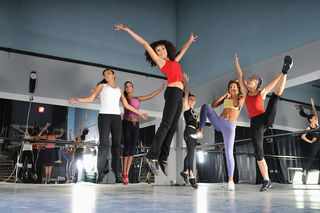What Is Dance Movement Therapy?
What Is Dance Movement Therapy?
Expressing yourself through movement can help connect the mind and body.

Source: shock/BigStock
Moving regularly is an investment in your mind, body, and soul. One of the more expressive ways to integrate movement into your eating disorder recovery is through dance therapy.
What Is Dance/Movement Therapy?
Defined, dance/movement therapy (DMT) in the US is the psychotherapeutic use of movement and dance to support intellectual, emotional, and motor functions of the body. As a form of expressive therapy, DMT looks at the correlation between movement and emotion.[1]
Also called “movement psychotherapy” there is no single fixed type of movement style used within this therapeutic exposure. Programs range from traditional dances like ballroom to more subtle forms of movement like yoga and stretching to calm the body. [2] It’s important to note that a DMT licensed practitioner would lead a session within a therapeutic setting. Therapy sessions are focused on movement behavior as it comes forward through the guided session.
Through this exposure, a therapist will use movement to help a client achieve emotional, cognitive, physical and social integration. The benefits include stress reduction and mood management. Within eating disorder recovery, it can also help improve body image and self-esteem. Founded within the idea that motion and emotion are interconnected, this creative expression can also help improve communication skills for better relationships. Movement can express aspects of a personality that a licensed therapist can be in tune with for deeper connection in recovery therapy.
Why Dance Therapy is Different from Regular Dancing
Movement in a dance therapy setting is more than just exercise. The actions, fluidity, and movement are interpreted more like a language. People who utilize dance therapy within an eating disorder treatment setting utilize movement to communicate conscious and unconscious feelings through dance. The therapist responds to the movements, assesses body language, nonverbal behaviors and emotional expressions to develop interventions to address the specific needs of the client. Movement is the primary way dance therapists observe, evaluate, and implement therapeutic intervention.
Some interventions include: [3]
- Mirroring. Matching and echoing the person’s movements to show empathy and validate what the person is feeling.
- Using a “movement metaphor” or prop to help a person physically and expressively demonstrate a therapeutic challenge or achievement. For example: a therapist may give a person in treatment a white flag to help celebrate emotional surrender.
Important skills that can be acquired during the process of dance movement therapy include: [4]
- Learning how to develop and trust your ability to be present empathetically.
- Being able to respond authentically and truthfully.
- Learning how to translate the nonverbal movements into insights that can be used in recovery.
How Dance Movement Therapy can be Beneficial
Feelings and life experiences live inside the body and can get trapped there. You don’t have to be a dancer to benefit from dance movement therapy. The body can be the key to unlocking profound levels of healing. DMT is not a dance class. It is a therapeutic exposure that can be used in conjunction with other eating disorder therapies to help access genuine, long lasting change.
Having a means to feel safe to understand and experience the sensations and feelings of your disorder are all part of the journey to recovery. Dance movement therapy can play an integral role in helping you re-claim an authentic connection between your actions and words.
Accessing Dance Movement Therapy
Many eating disorder treatment centers across the country offer this therapy option. Be sure to inquire during your research as to all of the therapeutic exposures that may be available to you. There is no one-size fits all approach to recovery and it is important to find the program that is a right fit for you.
Greta Gleissner is the Founder of Eating Disorder Recovery Specialists, a nationwide network of eating disorder treatment specialists that provide meal coaching and recovery skills such as CBT, DBT, ACT, MI, etc. EDRS works alongside treatment programs, teams and families to provide transitional aftercare support for post-residential treatment clients.
Resources:
[1] American Dance Therapy Association: adta
[2] eatingdisorderhope
[3] goodtherapy
[4] eatingdisorderhope

